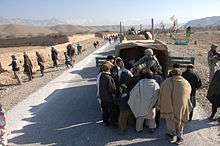Nijrab District
| Nijrab District | |
| District | |
| Country | Afghanistan |
|---|---|
| Region | Kapisa Province |
| Capital | Nijrab |
| Population | 99,600 (2006) |
 Nijrab District (in pink) | |
Nijrab District, (Persian: ولسوالی نجراب ) also called Nijraaw, is situated in the central part of Kapisa Province, Afghanistan. It is located in a valley about 120 km north of Kabul. It borders Mahmud Raqi and Koh Band districts to the west, Parvan Province to the north, Laghman Province and Alasay District to the east and Tagab District to the south. The population is 99,600 (2006) consisting of Tajiks, Pashtuns and Pashai.[1] The district center is Nijrab, located in the southern part of the district.
Geography
Nijrab District contains very rugged terrain and many areas are still inaccessible. The mountains that form the boundary with Laghman Province are the highest points in the district and reach a height of around 14,000 feet. Snowfall on the mountains melts slowly and flows into the valleys below. The farmers in Nijrab irrigate the melted snow to water their fields. The total population in Nijrab was a lot more than 100,000 back in 1950-1960s. Nijrab consists of 5 main valleys: Dara-e- Kalan, Dara-e- Ghaows, Daray-e- Pachaghan, Dara-e- Farokh Shah, And Kharij Dara. Sanjan Bolaghaeen, Gyiawa and Durnama belong to Woloswali-e- Kohband but few years back they were all part of Nijrab. the total population is Muslim and follow the Hanafi sect of Islam, 91.1% of the people living in Nijrab speak Persian, 2.9% pashto, 5% parachi, little people speaking pasha e they are Persians, pashton, pasha e and parachian and parachi is one language in kapesa province (or so called Tajik). The Tajik expression according to the history of Afghanistan, has no other meaning but Persian. It is just some political trick avoiding the Islamic republic of Iran, Afghanistan and Tajikistan from becoming one country. Nijrab district contains a number of villages, mostly grouped into seven valleys: Darah Kharj, Darah Ghawes, Darah Pachagan (Afghania, Pachagan, and G'yan), Darah Puta, Darah Farakh Shah, Darah Kalan, and Giawa. Temperatures are relatively warm, leading to a large number of animals such as insects, scorpions, and snakes in the district.
Rivers from the nearby Hindu Kush mountains and springs provide the majority of drinking water for district residents; however, hundreds of hand pump wells have been installed by the National Solidarity Program (NSP). Kapisa and Parwan PRT funded several more wells in late 2008 for Afghania.
Economy

The Nijrab district's economy is primarily agricultural, growing products such as wheat, corn, red beans, walnuts, almonds, and pine nuts.
Education
The district contains a number of primary and high schools. According to Nijrab's Director of Education Ghulam Mayudin, Nijrab has 44 schools. The Nijrab Department of Education is located in a rented office within the bazaar near the District Center. Nijrab suffers from a lack of qualified teachers, especially female teachers. Many schools in Nijrab have received new schools from several US and international organizations. The countries contributing the most to the funding of new schools in Nijrab are the US, Bangladesh (BRAC), and Japan.
Kapisa and Parwan PRT has recently (late 2008) approved funding for Kohi Girls School (Afghania), Shahed Nick mhomad (pachaghan), Mohammed Ayoob (Pachagan), khowaja roshnay walley (pachaghan), Engineer Habib Urahman (Kharj), Abdul Manan (Farakh Shah), and Abdul Salam (Pachagan). Qazi Abdul Jamil (Afghania) and Farakh Shah High School (Farakh Shah) were nearing completion as of December 2008.
All areas within Nijrab educate female students to include the Pashtun area of Afghania. There are several girls schools in Afghania. There was an incident in April 2008 in which the Taliban set fire to a girls school in the Afghania area. The villagers extinguished the fire and only one classroom was heavily damaged. Aside from that one act of arson, no attacks, threats, or acts of vandalism toward female schools had taken place during 2008. A large majority of villagers in Nijrab support the education of females and request new school buildings (half of the girls schools in Nijrab are without a building at all) with a perimeter wall for protection and privacy.
References
- ↑ "Microsoft Word - NEJRAB.DOC" (PDF). Retrieved 2013-07-06.
External links
| Wikimedia Commons has media related to Nijrab District. |